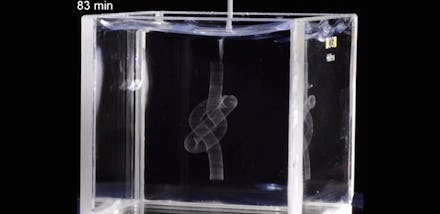Scientists Just Got Even Closer to Being Able to 3-D Print Human Organs

3-D printing is changing the game for medicine, but the technology still has limitations. For example, 3-D printing material generally needs to be solid. If you tried to 3-D print a fleshy human brain the way you'd make, say, a plastic Eiffel Tower or a sex toy, it would collapse under its own weight. But scientists at the University of Florida in Gainesville figured out how to keep that from happening.
According to a study published in Science Advances, the Gainesville team, lead by Thomas Angelini, printed models in an acrylic acidic polymer gel, a material that feels like hand sanitizer. It allowed the structures — in this case, organs, blood vessels and other biological tissue — to stay upright and not succumb to gravity.
Because the biological material is delicate and as thin as two sheets of paper, it doesn't withstand the same amount of weight as, say, the plastics printed in most basic printing setups. However, using the gel scaffolding, doctors could print extremely complex models without fearing that they'll fall apart. Eventually, they could even print human organs.
"We could foresee a future in which, before brain surgery, the surgeon 3-D prints a brain out of hydrogel and then practices on it," Angelini said, according to New Scientist. "Then the surgeon knows exactly how that surgery is going to happen."
The team's already been experimenting with actual living cells — like canine kidney cells — to print different organs. Because the biomaterials aren't actually organic, these first models would never be able to be actually transplanted as replacements for animals or humans. However, now that doctors have figured out how to keep a model of the human brain from collapsing into a pile of faux-gray-matter mush, they're a major leap closer to printing actual, implantable organs.
It may not be long before the donor list is replaced by a few printers and gallons of polymer gel.
h/t New Scientist